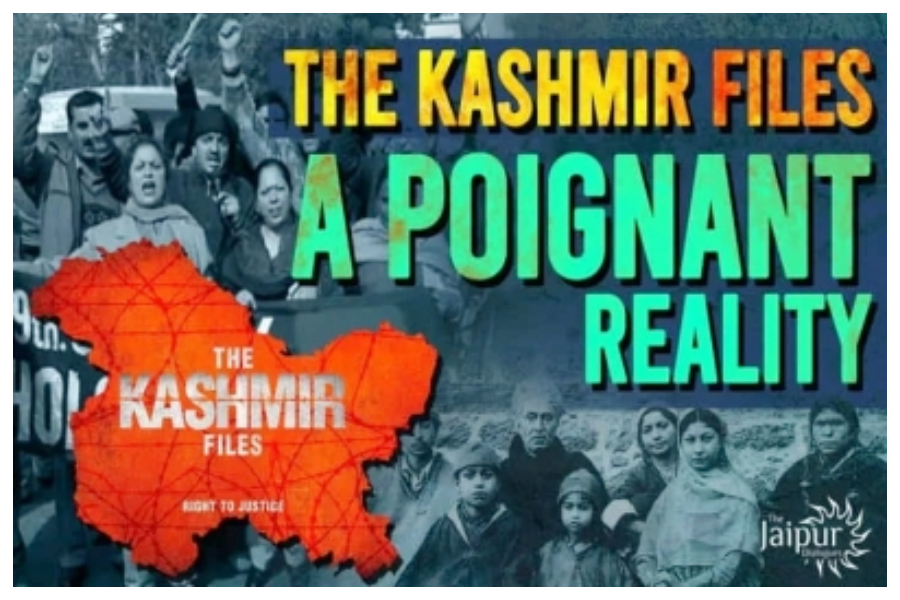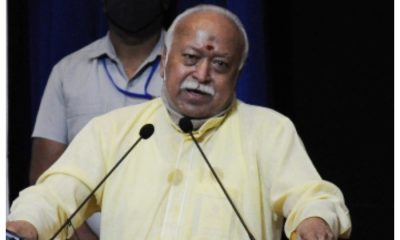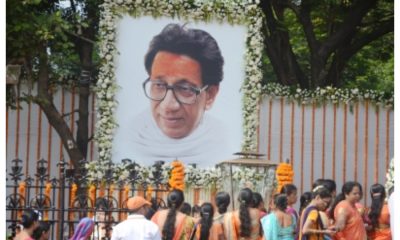Crime
Kashmir Files: A grim reminder of role of Pak ISI in ethnic cleansing of Kashmiri Pandits

“Kashmir Files”, a documentary film, has opened many wounds that were never healed even after more than three decades. There is not only one but countless true stories narrating the genocide of Kashmiri Pandit Community in the Kashmir valley. The film depicts the tragedies inflicted upon the Kashmiri pandits by the deep state of Pakistan and their loyalist terror outfits.
Though insurgency in Kashmir began in 1987 when Congress was in power in the centre. But by 1983, Pakistani dictator Zia ul Haq was fully prepared for covert operations against India, first in Punjab and subsequently in Kashmir. Zia’s policy laid down the foundation of Jihad. He believed that the Kashmir dispute would be solved in the context of an Islamic government in Afghanistan, a jihad in Kashmir and an uprising in Punjab in India. The late 1980s saw Islamic fundamentalism taking roots in the valley as a sequel to General Zia’s seminal strategy which intended to incite the locals into militancy. Zia was adamant to make Kashmir an Islamic issue and his policy spurred support of Pakistan’s fundamentalist parties and their loyalists in the Pakistani army and Inter-Services Intelligence (ISI).
Pakistan’s involvement in Afghanistan was an apprenticeship for its low intensity conflict in Kashmir. The cash, arms and ammunition provided by the US and channelled through the ISI found its way to the Pakistani arms market and finally to the radical organisations.
The withdrawal of the Soviet Union and later its disintegration convinced the Pakistani establishment regarding the capabilities of the well organised “jihadi” groups. Pakistan’s strategy was to engage them in a low- intensity conflict in Kashmir with rewarding results. Armed with sophisticated weapons and cash from the US, motivated through religious indoctrination and convinced about their dedication to the cause of Islam and their ultimate victory, this new breed of Islamic jihadis emerged as a new tool to execute the foreign policy objectives of Pakistani military establishment. It wanted to achieve Pakistan’s objective of inflicting damage to India. According to the Pakistani strategy, this would also succeed in internationalising the Kashmir issue and keep India under the pump.
Zia died in a plane crash in 1988 but under the tenure of Benazir Bhutto, the Pakistani army and ISI kept executing its own Kashmir agenda as usual.
In his book “Shadow War: The untold story of jihad in Kashmir”, Pakistani journalist Arif Jamal gives a detailed reports about how plans were discussed in Kathmandu on January 4, 1990. While pro-jihadi participants voiced concerns over the growing influence of the Jammu and Kashmir Liberation Front (JKLF) at the meeting, the founding leader of Jamat opposed direct involvement as it would destroy the organization and open it to an Indian security assault.
It was at this ISI sponsored meeting that pro-Pakistan separatist Syed Ali Shah Geelani suddenly appeared and made a passionate plea for openly supporting jihad in Kashmir. According to Jamal, that all the factions thereon supported jihad in Kashmir after this decisive meeting.
After consolidation, the ISI selected terrorist organisations to promote the next agenda – ethnic cleansing in Kashmir.
The diabolic project began with the targeting of Hindus in late 1989. The first to be killed was Pandit Tika Lal Taploo, a prominent leader of the Kashmiri Hindu Pandit community. Four months later, on 4January1990, Aftab, a local Urdu newspaper in Srinagar ran a press release issued by the Pakistan based terrorist outfit Hizbul Mujahideen, proclaiming jihad and asking all Hindus to leave the valley. Walls were plastered with posters asking Hindus to leave Kashmir, Hindu homes were dotted red and Hindu women were forced to sport marks on their foreheads (tilak); masked men with Kalashnikovs roamed the streets forcing people to reset their watches and clocks to Pakistan Standard Time.
With each passing day of January 1990, the tension mounted. Then on 19 January 1990, dubbed as the Kristallnacht of the Kashmiri Hindu Pandit community, the pressure reached its zenith. As dusk approached and Hindu families, women and children included, cowered inside their homes, behind the false security of their doors, outside the spine-chilling exhortations to leave the valley became louder and shriller. The muezzin’s routine calls to the Islamic faithful from mosque tops was replaced by three taped slogans that resonated throughout the cold January night asking Hindus to convert and follow the Shariat if they wanted to stay in Kashmir or to leave their wives and daughters behind.
Grabbing just what they could carry, uprooted Kashmiri Pandits were forced to leave the valley, leaving behind their ancestral homes.
All in all, according to IDMC (Internal Displacement Monitoring Center of the Norwegian Refugee Council) 350,621 Kashmiri Pandits or 90% of the Kashmiri Pandits who were living in the valley fled Kashmir.
According to a report by Shishir Gupta, Executive Editor, Hindustan Times, “the pattern on killings of Kashmiri Pandits by terrorists shows that the bulk of targeted attacks took place in 1990 with the onset of jihadi terrorism in the Valley. Subsequent killings dramatically dropped not because of a change in the intent of the Pak sponsored terror campaign but because the adversary had achieved their strategic goal-pogrom to cleanse the Valley”.
“The Pandits were killed primarily with the sinister jihadi agenda to establish Nizam-e-Mustafa in the Valley as part of a pogrom, the majority community were mostly killed as collateral damage during maintenance of law and order, encounters with terrorists, during grenade and IED attacks in the Valley. A considerable number were also targeted for variety of reasons ranging from suspected informers, refusing diktats of terror commanders related to women, money, or property as also terrorists taking sides and settling local disputes related to personal enmity,” writes Gupta quoting a senior Kashmir police officer.
“Although the Pakistani deep state is responsible for destroying communal cohesion in Kashmir in the 1990s, it was Islamabad’s then friend, the US, which failed to recognize terrorism in Kashmir till the J&K Assembly attack on October 1, 2001. Throughout the entire 1990s, the Valley was all about human rights with the US State Department and western media and their proxies in the Valley batting for Rawalpindi GHQ in the international fora and pinning down India on so-called violation of human rights. The US definition in the Valley changed from freedom fighter to militant to terrorist after the 9/11 attacks and the December 13, 2001, attack on the Indian Parliament,” says the report.
Things are changing for betterment since August 5, 2019 when Jammu and Kashmir was declared a Union Territory after article 370 was abrogated. Though the terror incidents have come down effectively but Pakistan is still trying to radicalise the local Kashmiri youth. Majority of Kashmiri pandits are still scared of going back to the valley, leaving their “settled” lives elsewhere. The Indian security agencies are on alert after the humiliating withdrawal by the US last year leaving sophisticated weapons worth billions of dollars with the Taliban in Afghanistan. There are apprehensions that the Taliban “affiliated” all Sunni Pakistani terror outfits may once again try to revive militancy in Kashmir.
“It is not the 1980s and this time Pakistan has been getting a taste of its own recipe. Baloch, TTP, ISIS all want their ‘booties, “says one intelligence officer adding, “but we can’t lower our guard.”
Crime
Mumbai Crime Branch Arrests Father Accused Of Killing 15-Year-Old Daughter And Injuring Wife In Vakola

Mumbai: The Mumbai Crime Branch arrested Mohammad Suleman Rajjak Kujra,40, accused of killing his 15-year-old daughter and injuring his wife in Vakola. On October 15, Kujra attacked his wife Nasima,35 and daughter Asgari with a heavy weapon after an argument at their Kalina home. Asgari succumbed to injuries, while Nasima was hospitalised.
An FIR was filed under Bharatiya Nyaya Sanhita at Vakola Police Station. Kujra fled to Bihar, but the Crime Branch tracked him using technical analysis. The team, including Inspector Laxmikant Salunkhe and others, apprehended him, ensuring justice for the victims.
Crime
Mumbai: Borivali Police Arrest Auto-Rickshaw Driver For Verbally Abusing And Physically Assaulting Traffic Constable On Duty

Mumbai: Borivali police arrested 39year-old auto-rickshaw driver Suresh Chettiyar for allegedly assaulting and verbally abusing traffic police on duty. The incident occurred around noon on Chandavarkar Road, Borivali West, where officers were towing illegally parked vehicles.
Chettiyar, a Gorai resident, reportedly blamed the police for traffic congestion, verbally abused them, and physically assaulted a constable by grabbing his collar. He also recorded the incident, threatening to make it viral.
Crime
Elderly Mumbai Residents Defrauded Of ₹4.79 Crore In Cyber Scam By Conmen Impersonating Police, CBI, And Telecom Officials

Mumbai: In a disturbing trend of cyber fraud targeting senior citizens in Mumbai, two elderly individuals were collectively defrauded of Rs4.79 crore by scammers posing as officials from the Telecom Department, Delhi Police, Colaba Police, and the CBI. The victims, 82-year-old Bidhin Manharlal Bakshi from Vile Parle (West) and 68-year-old Dhanalakshmi Satyanarayan Rao Naidu from Andheri (West), lodged complaints with the West Region Cyber Police Station, leading to FIRs against unidentified perpetrators under sections of the BNS and the Information Technology Act for impersonation, forgery, cheating, and criminal intimidation.
On September 30, Bakshi received a WhatsApp video call from an individual claiming to be Pawan Kumar from the Telecom Department in Delhi, alleging that Bakshi’s Aadhaar card was misused to open a fake Canara Bank account linked to illegal international transactions. Subsequent calls from fraudsters posing as Delhi Police sub-inspector Khushi Sharma and CBI officer Hemraj Kohli escalated the deception, claiming a criminal case was registered against him at Connaught Place Police Station. They warned of an imminent arrest warrant for Bakshi and his family unless he complied. Convinced by their threats, Bakshi transferred Rs1.08 crore from his and his wife’s accounts to “safe accounts” for a so-called clearance certificate, under strict instructions not to inform anyone.
Similarly, on August 18, Naidu received a call from a man identifying himself as Vijay Paul, connecting her to “SK Jaiswal” from Colaba Police via a WhatsApp video call. The fraudsters accused her of involvement in a Rs6 crore money laundering case linked to a Canara Bank account opened with her Aadhaar details, citing a fake case (HQ No. 8817) under the Prevention of Money Laundering Act. They claimed she was under investigation alongside businessman Naresh Goyal. A sham “online hearing” with a fake judge named Chandrachud denied her bail, pressuring her to transfer Rs3.71 crore from her mutual funds via RTGS for “security verification.” The scammers later demanded more money and became evasive when Naidu sought a refund.
Both victims, realising they were deceived, approached the West Region Cyber Police. Naidu also reported the fraud via the 1930 cybercrime helpline, providing chats, transaction details, and screenshots. The police are investigating the use of forged police and CBI logos, fabricated FIRs, and fake letters.
-

 Crime3 years ago
Crime3 years agoClass 10 student jumps to death in Jaipur
-

 Maharashtra1 year ago
Maharashtra1 year agoMumbai Local Train Update: Central Railway’s New Timetable Comes Into Effect; Check Full List Of Revised Timings & Stations
-

 Maharashtra1 year ago
Maharashtra1 year agoMumbai To Go Toll-Free Tonight! Maharashtra Govt Announces Complete Toll Waiver For Light Motor Vehicles At All 5 Entry Points Of City
-

 Maharashtra1 year ago
Maharashtra1 year agoFalse photo of Imtiaz Jaleel’s rally, exposing the fooling conspiracy
-

 National News1 year ago
National News1 year agoMinistry of Railways rolls out Special Drive 4.0 with focus on digitisation, cleanliness, inclusiveness and grievance redressal
-

 Maharashtra11 months ago
Maharashtra11 months agoMaharashtra Elections 2024: Mumbai Metro & BEST Services Extended Till Midnight On Voting Day
-

 National News1 year ago
National News1 year agoJ&K: 4 Jawans Killed, 28 Injured After Bus Carrying BSF Personnel For Poll Duty Falls Into Gorge In Budgam; Terrifying Visuals Surface
-

 Crime1 year ago
Crime1 year agoBaba Siddique Murder: Mumbai Police Unable To Get Lawrence Bishnoi Custody Due To Home Ministry Order, Says Report


















